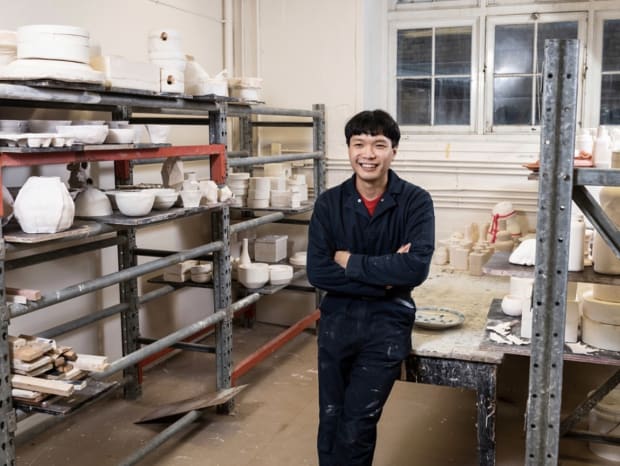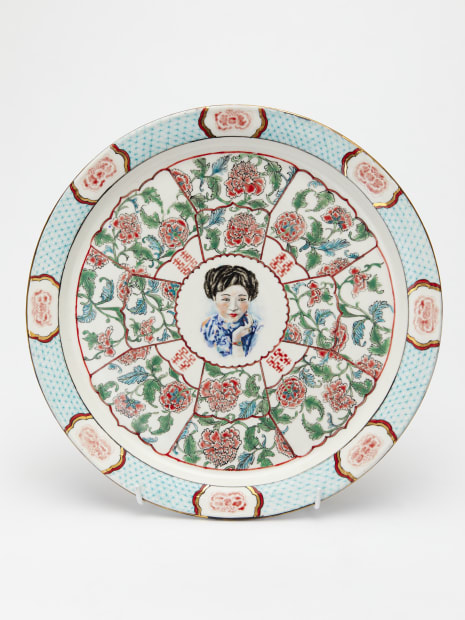-

-

-

-
-
 Casey ChenTeacup 1, 2022porcelain, enamels and gold lustre with cobalt underglaze; fired four times6 x 10.5 x 10.5 cmClick for more info.
Casey ChenTeacup 1, 2022porcelain, enamels and gold lustre with cobalt underglaze; fired four times6 x 10.5 x 10.5 cmClick for more info. -
 Casey ChenSentimental Ornament 2, 2022porcelain, enamels and gold lustre with cobalt underglaze; fired four times18.5 x 38 x 36.5 cmClick for more info.
Casey ChenSentimental Ornament 2, 2022porcelain, enamels and gold lustre with cobalt underglaze; fired four times18.5 x 38 x 36.5 cmClick for more info. -
 Casey ChenTeacup 2, 2022porcelain, enamels and gold lustre with cobalt underglaze; fired four times6 x 10.5 x 10.5 cmClick for more info.
Casey ChenTeacup 2, 2022porcelain, enamels and gold lustre with cobalt underglaze; fired four times6 x 10.5 x 10.5 cmClick for more info.
-
-
Interview with Casey Chen.
Your work explores nostalgia and your childhood; how does drawing on them impact your practice?
I like to draw upon a sense of my generation’s collective shared nostalgia for pop culture and I draw from a lot of visual motifs that are sourced from TV and magazines and music. Growing up I have fond memories of sitting in front of the TV and turning my brain into mush. These fond memories inform a lot of the subject matter for these works and I hope that it imparts a whimsical sentimentality to them.
I like the idea of ceramics being a vessel for memory and nostalgia. They’re robust and enduring objects that remain in your life and will likely outlast one’s lived lifetime.
Your works are often very personal — mostly suggestions of family members or memories. How do you envision audiences will experience your work?
They’re paintings on ceramics – I try and paint delicately when I can – of big robots and cartoons and ladies but I hope that you feel like I’m not taking myself too seriously. I try and have fun and hope that audiences can find a sense of humour in the works. They’re sentimental objects, but also paintings and ornaments that I hope you will appreciate.
How does your ceramics practice explore both traditional and contemporary art making practices?
My ceramic practice is fairly traditional – all the works are hand thrown and painted by me. I use a pottery wheel or roll out sheets of clay to use on a slump mould if it’s a rectangular plate or decorated with filigree.
Everything is fired three times: once in a biscuit firing, then glazed, then fired at a lower temperature for the enamel firing and that’s when the colours are normally added - much like in Chinese doucai or wucai painting.
In what ways does Sentimental Ornaments utilise the emotive potential of colour, tone, shape (and any other relevant elements) in telling a story
Sentimental Ornaments features some of the most delicate works I’ve made. The paintings are layered up and behave much like watercolours. My favourite example of the works was in Lady wreathed in Peonies as well as Sentimental Ornament, which are more adventurous and emotive in choice of colour and tone with the figure paintings as well as visual ornamentation surrounding the works. So much so that the pieces are namesakes of the show.
Can you share some insights into the process of creating Sentimental Ornaments?
Sentimental Ornaments was an exhibition I should have allowed myself more time for and that’s something I’m still trying to work out. Lockdown was both a boon and also thorn in my side. Luckily I was allowed to be in the studio every day, but there was also very little to do outside of home beyond that and so it dulled my focus.
I just begin by throwing the works and firing these in batches, so that I can work on numerous works stage-by-stage and group firings together. I had ample time to produce work, but also my interest began flagging when I was doing nothing but be in the studio, day in, day out, which I’ve learned isn’t very efficient.
How do you decide on the visual compositions of the works?
I draw periodically and keep these drawings in a book. I also keep a library of visual motifs I’ve made and geometric patterns that I like. Often, the works may just be a combination of sourced and drawn material that I’ve photoshopped with patterns, which I use as reference material when I’m ready to paint the works.
What do you hope your audiences will take away with them after viewing your works?
I hope that they enjoy the sight of the works; they’re tactile and cool to the touch and meant to be picked up gently. I hope that the works appeal to the sense of humour within them and that they can be a container of fond memories as well.









